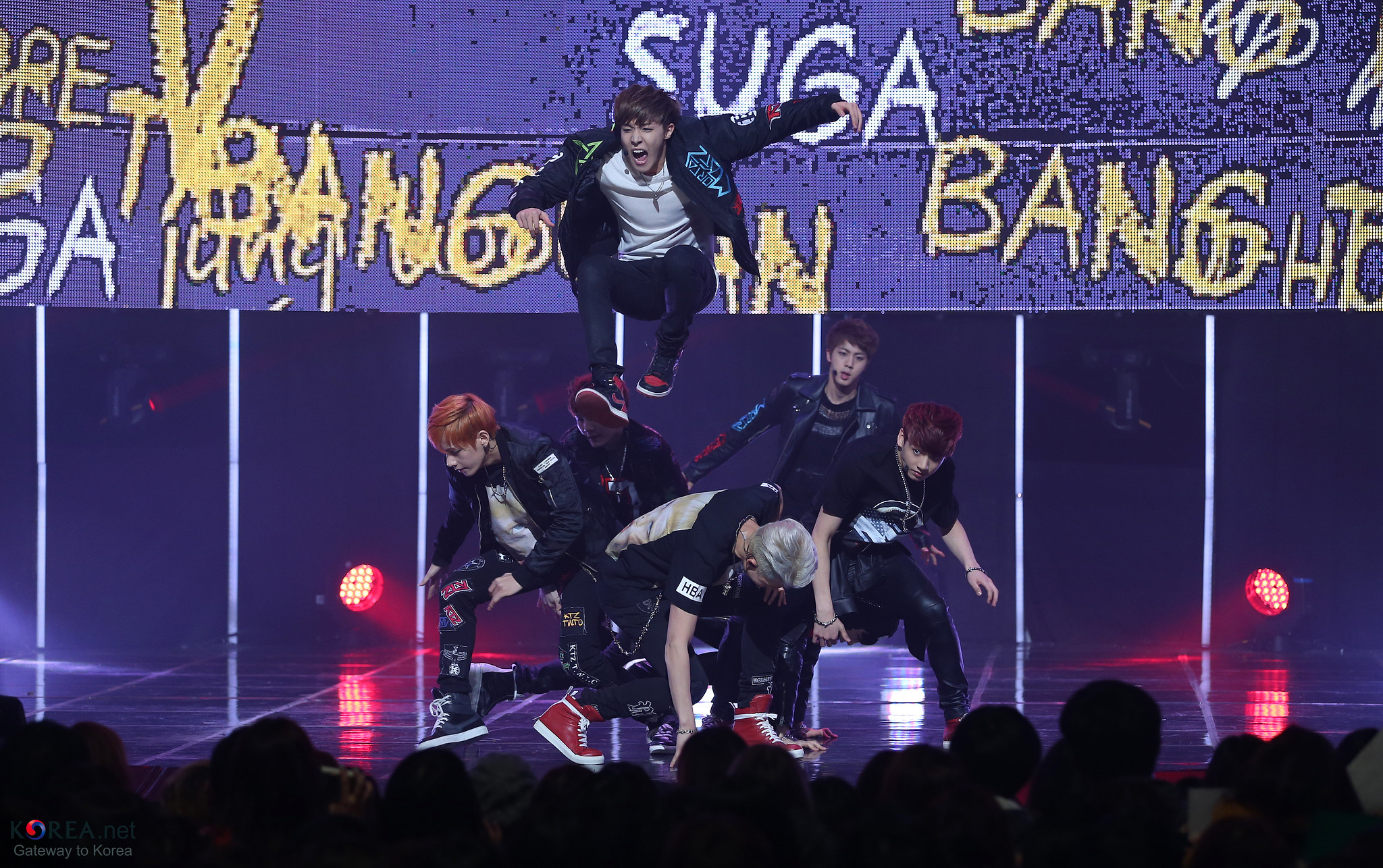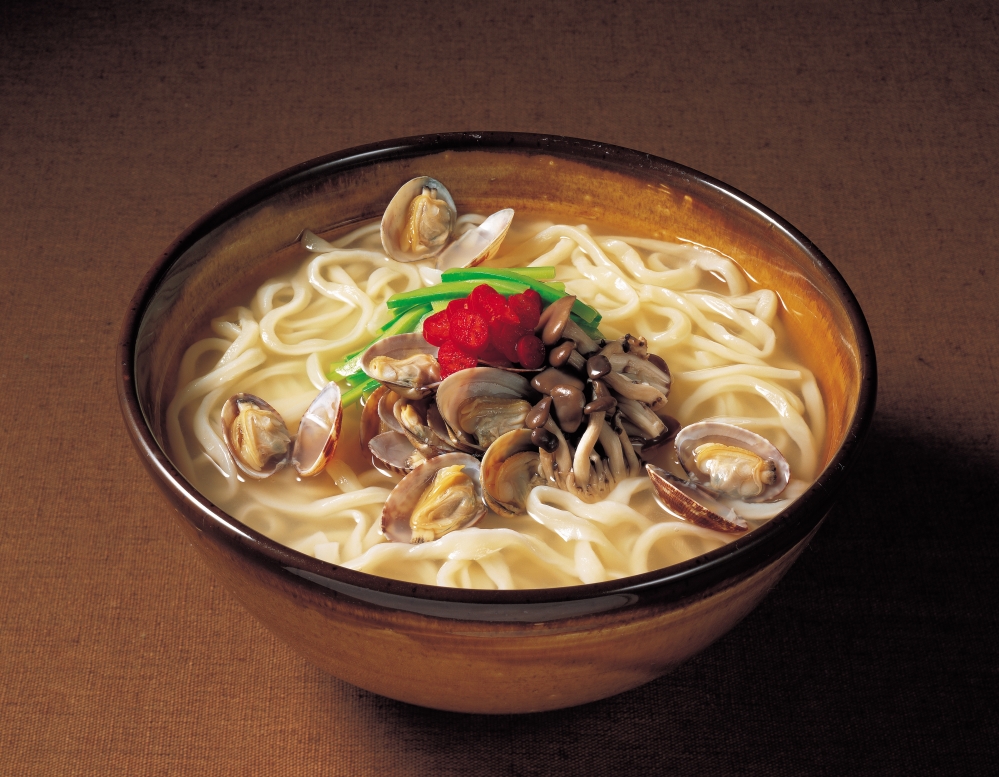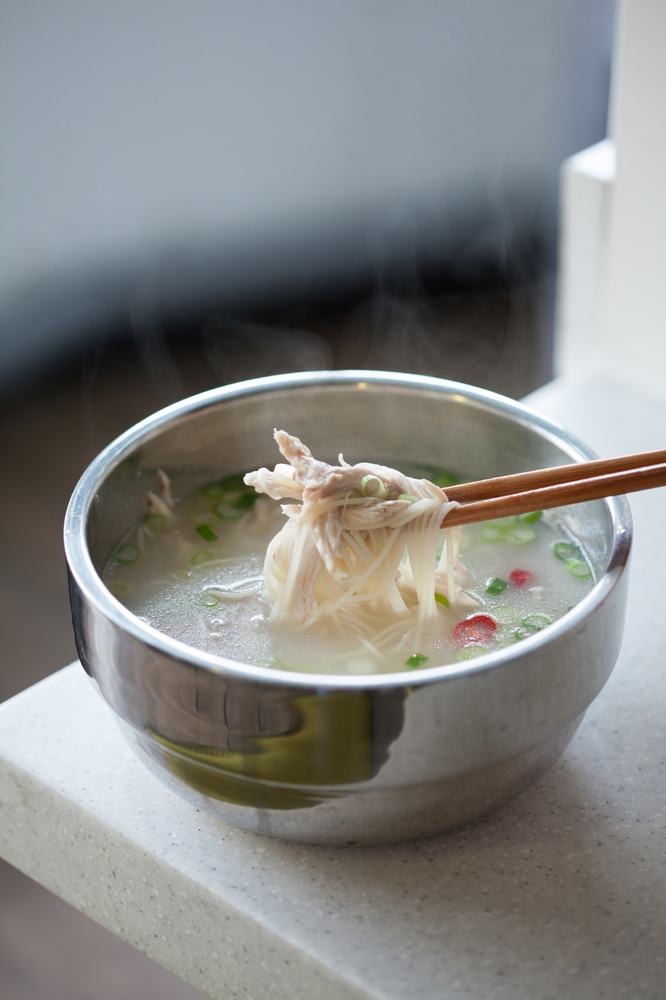-
 Korea.net's 24-hour YouTube channel
Korea.net's 24-hour YouTube channel- NEWS FOCUS
- ABOUT KOREA
- EVENTS
- RESOURCES
- GOVERNMENT
- ABOUT US
View this article in another language
- 한국어
- English
- 日本語
- 中文
- العربية
- Español
- Français
- Deutsch
- Pусский
- Tiếng Việt
- Indonesian
By Honorary Reporter Sara Samy Aly Maharem from Egypt

The song "Chicken Noodle Soup" by J-hope featuring Becky G has made a great splash on the music industry, as J-Hope, the rapper of the super K-pop boy band Bangtan Boys aka BTS, remade the 2006 American rap tune of the same name by Webstar featuring Young B and the Voice of Harlem into a multi-lingual and multi-cultural song featuring Korean, Spanish and English. J-Hope's work shows that language is no barrier for showing and expressing oneself and that differences in mother tongue, culture, music and dance and mixing them can be powerful.
The food chicken noodle soup is a time-honored dish not only in the U.S. but even in my own homeland of Egypt. I remember my mom always gave me this especially when the weather started getting cool as summer days came to an end. The soup is also famous in Korea, where its name is dak-kalguksu, which literally means "chicken noodle soup." I have a good story to tell and as usual, it's related to history. So get your chopsticks ready.
Kalguksu is homemade noodles made from wheat flour and eggs, and ground bean powder is sometimes added to the mixture to form dough. The dough is rolled and then cut into long strips with a knife to form what looks like normal noodles but thicker. This is why the literal translation of kalguksu is "knife noodles." The dish is served in this form, the noodles are added to a bowl with the broth of chicken, anchovy or shellfish and extras added include vegetables like zucchini, potatoes and scallions that are cooked with the noodles. In the end, pieces of the broth's meat are added and seasoned with salt and pepper. Check the internet, a Korean food guide or the food app by the Korea Foundation to get the recipe for any Korean food.
The way kalguksu is cooked and the ingredients added create different versions of the dish. Jemul kalguksu is noodles put to a boil with other ingredients in broth instead of being added later, resulting in a thick texture for both noodles and broth. Ssuk (mugwort) kalguksu has mugwort added to the dough when making the noodles and is commonly served in anchovy broth. Nokdu (mung bean) kalguksu requires boiled mung beans being crushed, sieved and added to the noodle dough. For hobak (pumpkin) kalguksu , the noodles are cooked with a porridge-like mixture of red beans and rice and served in a hollowed-out pumpkin. Deulkkae (perilla seed) kalguksu features finely ground perilla seeds added to the broth seasoned with soy sauce and garnished with zucchini and shiitake mushrooms. For Andong kalguksu, ground bean powder is added to the flour and the broth is usually made from chicken. As for dakkalguksu , it is cooked in the common way mentioned above and normally takes 50-90 minutes to prepare.

According to Korean history, kalguksu originated from the ancient Goryeo era as documents from that time mentioned that noodles were only served to nobles and at special occasions. They also said Korea used to import noodles from China at the time but lacked a clear description of the dish. The first Korean document to mention the noodles was from the Joseon Dynasty era (1392-1910). A recipe for noodles appears in the cookbook Eumsik Dimibang (Understanding the Flavor of Food) written by Lady Jang Gye-hyang in 1670. Wheat noodles at the time were expensive due to the reduction of wheat production, as wheat was relatively unknown to the masses and geared toward nobles and the higher class.
Things changed in 1953 after the Korean War, as the U.S. began to supply wheat for use as food to ordinary people. And through the improvement of the Korean economy, wheat noodles became a common food for Koreans, who loved to eat it especially on rainy summer days. Kalguksu is said to be the refreshment for Koreans on rainy days.
Kalguksu was also often served on a child's first birthday to accompany a prayer of five blessings for the youngster: longevity, wealth, health, virtue and a peaceful death. The noodles also used to be served to guests at weddings to hope for a long-lasting marriage between the newlyweds.
Since ancient days, Koreans have considered the harvest a major occasion for celebration. As one of Korea's numerous festivals related to the harvest, Yudu is known as the water festival. People would gather crops of fruit and wheat and offer them to the gods in the hope of seeing a bountiful harvest. Dating back to the ancient Silla era, the festival is observed on the 15th day of the sixth month of the lunar calendar when crops are grown and ready to be harvested.
Another Yudu custom was for people to go to flowing water on a mountain located in the east to wash their heads. They gathered at waters running eastward as the east symbolized youth and positive energy. Washing one's head under such water was believed to ward off bad spirits and clean the soul. Another tradition was to offer crops to the gods of the mountain and the river as sacrifices in return for their blessings and good wishes for the first harvest. Since wheat is harvested during the Yudu season, kalguksu is considered a common dish served on the feast day. Koreans believed that eating noodle soup that day ensured huge energy and good hope for the rest of the year, considering it a good start for achieving their goals and having a successful year. All this started with consuming a bowl of kalguksu during the Yudu feast. A slogan about this custom says "Kalguksu is your first step to shine."
Maybe this was what J-Hope was thinking when he decided to remake "Chicken Noodle Soup." He said the American original was a song he used to dance to in dance classes in his hometown. After a long training period and experiencing the ups and downs of show biz, the BTS rapper is now gathering his first harvest from his hard work. To show gratitude to his past, he remade his old friend with a new flair. With his former dance teacher doing the choreography, J-Hope paid tribute to the original while adding his own touch to it.
"From Gwangju, one gang of you-know-what. Geum-nam Chung-jang Street, that's my Harlem. Joined Neuron, bounce with my team, ayy. Went head over heels for dancing, workaholic, every day. As a teen, grew up pulling all-nighters, that's the case. My height is measured by dance, I'm OK. A grand vision, a plan I'm going on to draw. A kid who goes on to shape his dream. Steps stomping over the rhythm. Popping, rocking, hopping, tutting, dougie, flexing, swaggin' (woah). Still do the work every day, ASAP, for my own sake (woah). Always whipping myself, the carrots are on the trophies. Betting on my life, dancing is my cash. Hope on the street, now it's my own way. With Becky G on the side, every day I'm lit (get it!). ”
- J-hope.

These lyrics express the long path J-hope followed to make his dream come true. He thanks his former dance teacher, his ex-team and even the songs he used to dance to. He remembers his hard days, promises to continue shining with the same vibe he started with to stay on top and treasures his memories. He lets it rain with all the hope the rain has and washes his head under it and then clears his own harvest. Finally, he eats a bowl of dak-kalguksu to rejuvenate himself.
So that is the story behind Korea's chicken noodle soup dak-kalguksu. I believe that after reading this article, people might find the taste of the dish different. And don't forget to add a soda on the side.
chaey0726@korea.kr
*This article is written by a Korea.net Honorary Reporter. Our group of Honorary Reporters are from all around the world, and they share with Korea.net their love and passion for all things Korean.

(Korea.net DB)
The song "Chicken Noodle Soup" by J-hope featuring Becky G has made a great splash on the music industry, as J-Hope, the rapper of the super K-pop boy band Bangtan Boys aka BTS, remade the 2006 American rap tune of the same name by Webstar featuring Young B and the Voice of Harlem into a multi-lingual and multi-cultural song featuring Korean, Spanish and English. J-Hope's work shows that language is no barrier for showing and expressing oneself and that differences in mother tongue, culture, music and dance and mixing them can be powerful.
The food chicken noodle soup is a time-honored dish not only in the U.S. but even in my own homeland of Egypt. I remember my mom always gave me this especially when the weather started getting cool as summer days came to an end. The soup is also famous in Korea, where its name is dak-kalguksu, which literally means "chicken noodle soup." I have a good story to tell and as usual, it's related to history. So get your chopsticks ready.
Kalguksu is homemade noodles made from wheat flour and eggs, and ground bean powder is sometimes added to the mixture to form dough. The dough is rolled and then cut into long strips with a knife to form what looks like normal noodles but thicker. This is why the literal translation of kalguksu is "knife noodles." The dish is served in this form, the noodles are added to a bowl with the broth of chicken, anchovy or shellfish and extras added include vegetables like zucchini, potatoes and scallions that are cooked with the noodles. In the end, pieces of the broth's meat are added and seasoned with salt and pepper. Check the internet, a Korean food guide or the food app by the Korea Foundation to get the recipe for any Korean food.
The way kalguksu is cooked and the ingredients added create different versions of the dish. Jemul kalguksu is noodles put to a boil with other ingredients in broth instead of being added later, resulting in a thick texture for both noodles and broth. Ssuk (mugwort) kalguksu has mugwort added to the dough when making the noodles and is commonly served in anchovy broth. Nokdu (mung bean) kalguksu requires boiled mung beans being crushed, sieved and added to the noodle dough. For hobak (pumpkin) kalguksu , the noodles are cooked with a porridge-like mixture of red beans and rice and served in a hollowed-out pumpkin. Deulkkae (perilla seed) kalguksu features finely ground perilla seeds added to the broth seasoned with soy sauce and garnished with zucchini and shiitake mushrooms. For Andong kalguksu, ground bean powder is added to the flour and the broth is usually made from chicken. As for dakkalguksu , it is cooked in the common way mentioned above and normally takes 50-90 minutes to prepare.

(iclickart)
According to Korean history, kalguksu originated from the ancient Goryeo era as documents from that time mentioned that noodles were only served to nobles and at special occasions. They also said Korea used to import noodles from China at the time but lacked a clear description of the dish. The first Korean document to mention the noodles was from the Joseon Dynasty era (1392-1910). A recipe for noodles appears in the cookbook Eumsik Dimibang (Understanding the Flavor of Food) written by Lady Jang Gye-hyang in 1670. Wheat noodles at the time were expensive due to the reduction of wheat production, as wheat was relatively unknown to the masses and geared toward nobles and the higher class.
Things changed in 1953 after the Korean War, as the U.S. began to supply wheat for use as food to ordinary people. And through the improvement of the Korean economy, wheat noodles became a common food for Koreans, who loved to eat it especially on rainy summer days. Kalguksu is said to be the refreshment for Koreans on rainy days.
Kalguksu was also often served on a child's first birthday to accompany a prayer of five blessings for the youngster: longevity, wealth, health, virtue and a peaceful death. The noodles also used to be served to guests at weddings to hope for a long-lasting marriage between the newlyweds.
Since ancient days, Koreans have considered the harvest a major occasion for celebration. As one of Korea's numerous festivals related to the harvest, Yudu is known as the water festival. People would gather crops of fruit and wheat and offer them to the gods in the hope of seeing a bountiful harvest. Dating back to the ancient Silla era, the festival is observed on the 15th day of the sixth month of the lunar calendar when crops are grown and ready to be harvested.
Another Yudu custom was for people to go to flowing water on a mountain located in the east to wash their heads. They gathered at waters running eastward as the east symbolized youth and positive energy. Washing one's head under such water was believed to ward off bad spirits and clean the soul. Another tradition was to offer crops to the gods of the mountain and the river as sacrifices in return for their blessings and good wishes for the first harvest. Since wheat is harvested during the Yudu season, kalguksu is considered a common dish served on the feast day. Koreans believed that eating noodle soup that day ensured huge energy and good hope for the rest of the year, considering it a good start for achieving their goals and having a successful year. All this started with consuming a bowl of kalguksu during the Yudu feast. A slogan about this custom says "Kalguksu is your first step to shine."
Maybe this was what J-Hope was thinking when he decided to remake "Chicken Noodle Soup." He said the American original was a song he used to dance to in dance classes in his hometown. After a long training period and experiencing the ups and downs of show biz, the BTS rapper is now gathering his first harvest from his hard work. To show gratitude to his past, he remade his old friend with a new flair. With his former dance teacher doing the choreography, J-Hope paid tribute to the original while adding his own touch to it.
"From Gwangju, one gang of you-know-what. Geum-nam Chung-jang Street, that's my Harlem. Joined Neuron, bounce with my team, ayy. Went head over heels for dancing, workaholic, every day. As a teen, grew up pulling all-nighters, that's the case. My height is measured by dance, I'm OK. A grand vision, a plan I'm going on to draw. A kid who goes on to shape his dream. Steps stomping over the rhythm. Popping, rocking, hopping, tutting, dougie, flexing, swaggin' (woah). Still do the work every day, ASAP, for my own sake (woah). Always whipping myself, the carrots are on the trophies. Betting on my life, dancing is my cash. Hope on the street, now it's my own way. With Becky G on the side, every day I'm lit (get it!). ”
- J-hope.

(iclickart)
These lyrics express the long path J-hope followed to make his dream come true. He thanks his former dance teacher, his ex-team and even the songs he used to dance to. He remembers his hard days, promises to continue shining with the same vibe he started with to stay on top and treasures his memories. He lets it rain with all the hope the rain has and washes his head under it and then clears his own harvest. Finally, he eats a bowl of dak-kalguksu to rejuvenate himself.
So that is the story behind Korea's chicken noodle soup dak-kalguksu. I believe that after reading this article, people might find the taste of the dish different. And don't forget to add a soda on the side.
chaey0726@korea.kr
*This article is written by a Korea.net Honorary Reporter. Our group of Honorary Reporters are from all around the world, and they share with Korea.net their love and passion for all things Korean.
Most popular
- First hearing-impaired K-pop act hopes for 'barrier-free world'
- Expats could account for 7% of population in 20 years: report
- 'Mad Max' director impressed by 'cinema-literate' Korean viewers
- Show in Italy to present 'thought-filled' Korean craftworks
- Romanian presidential couple visits national cemetery













